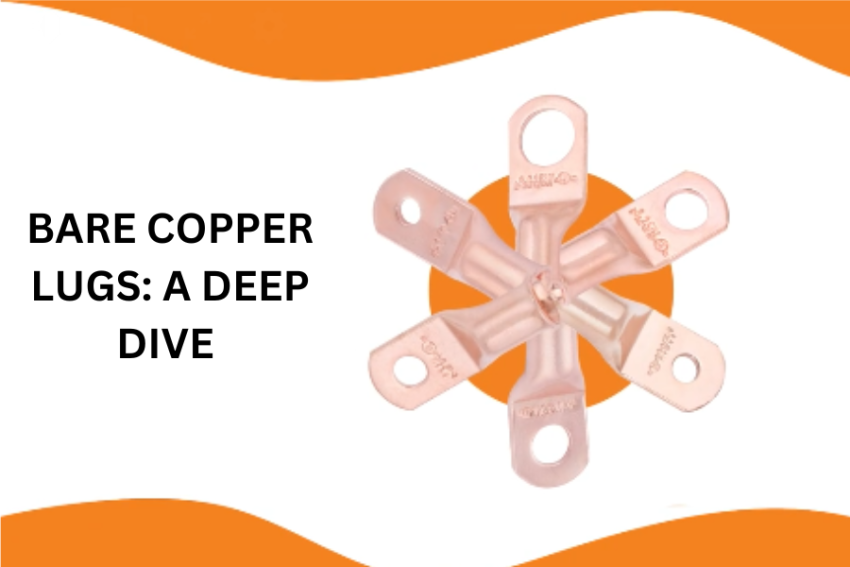Bare copper lugs, often overlooked but indispensable components in electrical and mechanical systems, play a crucial role in ensuring secure and reliable connections. These small yet powerful elements are pivotal in various applications, from automotive to industrial settings. This article explores the intricacies of bare copper lugs, their types, uses, advantages, and considerations for selecting the right ones for your needs.
What Are Bare Copper Lugs?
Bare copper lugs are electrical connectors used to terminate electrical conductors and connect them to different devices or surfaces. Made from high-purity copper, these lugs are known for their excellent electrical conductivity and resistance to corrosion. The term “bare” indicates that these lugs are not coated with any insulating material, allowing for direct metal-to-metal contact, which is essential for efficient current flow.
Types of Bare Copper Lugs
1. Compression Lugs: These lugs are designed to be crimped onto the conductor using a compression tool. They provide a secure and permanent connection, making them ideal for high-vibration environments. Compression lugs come in various sizes to accommodate different wire gauges.
2. Mechanical Lugs: Unlike compression lugs, mechanical lugs use screws or bolts to clamp the conductor in place. They are reusable and easier to install and remove, making them suitable for temporary connections or situations where the lug might need to be adjusted frequently.
3. Solder Lugs: These lugs require soldering to attach the conductor. While they provide a very secure connection, the process is more time-consuming and requires additional tools and skills. Solder lugs are often used in applications where the utmost reliability is needed.
Applications of Bare Copper Lugs
1. Automotive Industry: In vehicles, Bare Copper Battery Terminal Connectors
are used to connect batteries, starters, and other electrical components. Their high conductivity ensures that power is efficiently transferred, which is critical for the performance and reliability of the vehicle.
2. Industrial Machinery: Bare copper lugs are integral in industrial settings for connecting heavy-duty machinery and equipment. They are used in power distribution systems, motor control centers, and other high-current applications where durability and reliability are paramount.
3. Renewable Energy Systems: In solar and wind energy installations, bare copper cable lugs are used to connect various components of the power generation system. Their ability to handle high currents and resist environmental degradation makes them ideal for these applications.
4. Residential Electrical Systems: Bare copper lugs are also used in residential wiring, particularly in main service panels and grounding systems. Their ease of installation and excellent conductivity ensure safe and reliable electrical connections in homes.
Advantages of Bare Copper Lugs
1. High Conductivity: Copper is known for its superior electrical conductivity, second only to silver. Bare copper lugs ensure minimal energy loss during transmission, making them highly efficient.
2. Corrosion Resistance: Copper naturally forms a protective oxide layer that prevents further corrosion. This property ensures that bare copper lugs maintain their performance over time, even in harsh environments.
3. Durability: Bare copper lugs are robust and can withstand mechanical stress and high temperatures. This durability makes them suitable for demanding applications where reliability is critical.
4. Versatility: With various types and sizes available, bare copper lugs can be used in a wide range of applications, from small-scale residential projects to large industrial systems.
Considerations for Selecting Bare Copper Lugs
1. Wire Size: Ensure that the lug is compatible with the size of the conductor. Using the wrong size can lead to poor connections, increased resistance, and potential safety hazards.
2. Type of Connection: Choose the appropriate type of lug based on the application and installation requirements. Compression lugs are ideal for permanent connections, while mechanical lugs are better for temporary or adjustable connections.
3. Environmental Conditions: Consider the environmental conditions in which the lug will be used. For corrosive environments, additional protective measures such as plating or sealing might be necessary.
4. Current Rating: Ensure that the lug can handle the current load of the application. Using a lug with an inadequate current rating can lead to overheating and failure.
5. Standards and Certifications: Look for lugs that meet industry standards and certifications, such as those from the National Electrical Manufacturers Association (NEMA) or Underwriters Laboratories (UL). These certifications ensure that the lugs have been tested for safety and performance.
Conclusion
Bare copper Battery Terminal Connectors may be small components, but their impact on electrical systems is significant. Their high conductivity, durability, and versatility make them indispensable in various applications, from automotive and industrial machinery to renewable energy and residential wiring. By understanding the different types of bare copper lugs, their applications, and the factors to consider when selecting them, you can ensure that your electrical connections are safe, reliable, and efficient. Whether you are an engineer, electrician, or DIY enthusiast, appreciating the role of bare copper lugs will enhance your ability to create robust and effective electrical systems.

